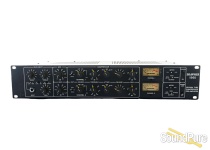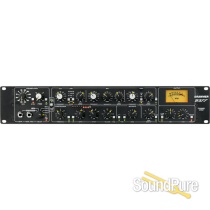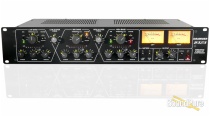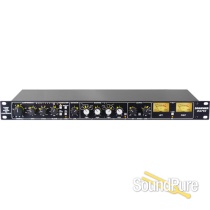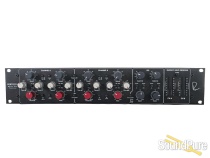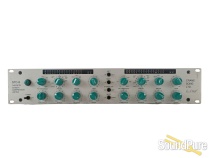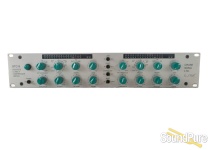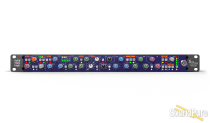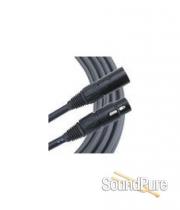-
Call Us Toll Free888-528-9703
-
Local/International (+1)919-682-5552
- Call Us! Toll Free! 888-528-9703
- Local / International (+1) 919-682-5552

Manufacturer's Description from Drawmer
The human voice is one of the most diverse signals ever encountered by engineers because it contains such large variations in level and harmonic structure. Getting the desired vocal sound can sometimes prove difficult. Setting the E.Q. to give the vocal sufficient 'definition' and 'cut' in the mix can cause large sibilant peaks which often lead to severe distortion. The MX50 'Vocal' De-Esser solves these problems quickly and efficiently by reducing the level of the sibilant sounds whilst leaving the remainder of the signal unchanged. The MX50 is a flexible, simple to set up dual De-Esser designed to fulfil the needs of the Recording Studio, Broadcast, Theatre and Live Sound Industries. Its classic application is to overcome the problems that can arise when sibilant sounds (S's and T's) are over-emphasised by the human voice, with such other applications as 'smoothing' a stereo mix, reducing string noise on acoustic guitars or breath noise on flutes, even refining cymbal and hi-hat sounds. Processing is achieved by adjusting just two control parameters, Frequency and De-Ess. The fully variable Frequency control operates from 800Hz to 8KHz encompassing the full sibilant range, including 'hard' sounding harmonics and other side-effects which can be generated when treble frequencies are boosted or enhanced. This is followed by the variable De-Ess which acts as a 'more' control giving up to 20dB of gain reduction at the selected frequency. The MX50 has two modes of operation: Split Band de-essing Recommended for the majority of applications, this mode splits the audio spectrum into two bands with the split point being dictated by the position of the Frequency control. Only frequencies above the split point are attenuated. Full Band de-essing A useful alternative where unobtrusive minimal processing is required. This mode reduces the total signal level in response to sibilant peaks in the selected frequency band. Further features are also incorporated to improve ease of control and flexibility: Floating Threshold System: This intelligent Drawmer circuitry has a floating Threshold that adapts to the dynamics and level of the incoming material, eliminating the need for a manual Threshold control and creating more natural results. Air function: As sibilance rarely occurs above 10KHz this feature adds back high frequency 'gloss' in excess of 12KHz preserving upper harmonics and increasing the transparency of operation. Frequency: This control selects the frequency band in which the de-esser operates. In Split Band mode this control also determines the split point above which gain reduction will take place. The control is continuously variable from 800Hz to 8KHz and covers the full sibilant range. De-Ess: Adjusts the amount of gain reduction that will take place when a sibilant sound has been detected. Up to a maximum of 20dB may be applied. This control uses an intelligent Floating Threshold circuitry which removes the need for a manual De-Ess Threshold control. One of the benefits of this design approach is that during quiet passages the sibilants are held to a level which is relative to the original signal. Split Band De-Ess: Split Band operation will only reduce the selected frequencies above the value set via the Frequency control. In most situations this mode, in conjunction with the Air function, offers the most transparent de-essing. Status LED illuminates when engaged. Full Band De-Ess: Full Band operation will reduce the total signal level in response to signals in the selected frequency band. Status LED illuminates when engaged. Air: The Air control enables frequencies above the sibilant band to be retained, greatly increasing transparency of the de-essing process. During normal use it is recommended to keep the Air function active for both Split Band and Full Band de-essing. Status LED illuminates when engaged. Link: Depressing this switch configures the unit for stereo operation where the average left/right signal level is used as the Floating Threshold. In linked mode the red status LED beneath the link switch will illuminate. De-Ess Gain Reduction Display: A nine segment LED bargraph shows how much gain reduction is being applied up to a maximum of 20dB. In Full Band mode gain reduction is applied to the whole signal, whilst in Split Band mode only frequencies above the value set on the frequency control are subject to gain reduction Bypass: The Bypass position routes the input signal to the output with no processing. These switches are independant of any linking and will only bypass their respective channel. Status LED illuminates when engaged.
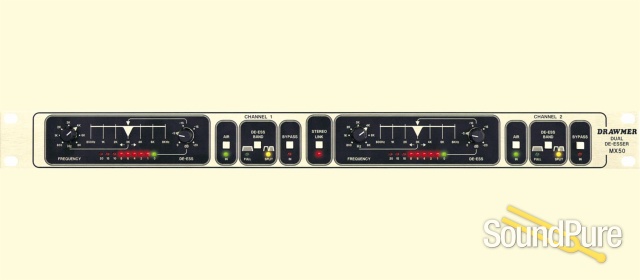
About Manufacturer
Specifications
MX50 TECHNICAL SPECIFICATIONS (Measurements taken using +4dBu balanced XLR input where applicable) INPUT IMPEDANCE 20K Ohms (bal), 20K Ohms (unbal) MAXIMUM INPUT LEVEL +21dBu INPUT CMR > -40dB OUTPUT IMPEDANCE 50 Ohms (bal), 100 Ohms (unbal) MAXIMUM OUTPUT LEVEL +21dBu BANDWIDTH 12Hz to 51KHz -1dB CROSSTALK @ 35KHz -98dB @ 1KHz below noise level NOISE Wideband (worst case) 22Hz - 22KHz AV -99dB -95dB DISTORTION Typical Input 100Hz 1KHz 10KHz Unity Gain, +4dBu input <0.03% <0.02% <0.03% +14dBu input, 10dB Gain Red <0.2% <0.2% <0.2% POWER REQUIREMENTS 115Volt or 230Volt at 50-60Hz, 9 Watts FUSE RATING T32mA for 230Volt, T63mA for 115Volt CONFORMING TO BS EN 60127-2:1991 SHEET III FUSE TYPE 20mm x 5mm, Class 3 Slo-Blo, 250Volt working CASE SIZE 482mm (w) x 44mm (h) x 200mm (d) WEIGHT (incl packaging) 3.2 Kgs




